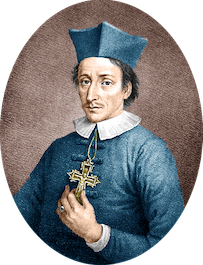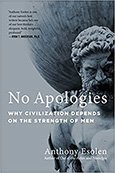The Rock of Ages
- ANTHONY ESOLEN
By the time he was thirty, Nicolas Steno had made a whole lifetime of discovery in several fields of science.
Join the worldwide Magnificat family by subscribing now: Your prayer life will never be the same!
 Blessed Nicolas Steno
Blessed Nicolas Steno1638–1686
The year is 1684. Imagine a couple of rich merchants, well stuffed from a good dinner, walking the streets of Hamburg, the great mercantile city on the River Elbe.
"The bishop is a fool or a hypocrite or both. No man can live the way he does."
"They say he has only bread and beer four days a week."
"It's gone to his brain."
"He studies the brain, doesn't he?"
"A heretic. Why would he sell his bishop's ring? Why doesn't he wear the robes of his office? Giving all to the poor, indeed!"
"Regard the lilies of the field, how they grow."
"Don't talk to me about lilies. We must get rid of this pest. The people of Hamburg know that God rewards the pious. He is an anatomist, yes? Let's give him some of his own to study."
"What do you mean?"
"Cut off his ears and nose."
A man of careful observation
The bishop, Nicolas Steno (1638-1686) — Niels Steensen, as he was christened in his native Denmark — had grown up as a frail little boy in a devoutly Lutheran home. He couldn't play with the other children, so instead he learned to listen to the grownups and their talk about serious matters. He became a man of many learned friends, with the patience to look at things very closely before pronouncing upon them.
He was humble enough to admit it, and brave enough to rebuke famous men who claimed to know more than they did, such as his friend Descartes, who said that the human soul resided in the pineal gland.
By the time he was thirty, Steno had made a whole lifetime of discovery in several fields of science. His first love was anatomy. He discovered the tube that brings saliva from the gland to the mouth; it is called Stensen's duct. He said, against common opinion, that when muscles contract, their shape changes but not their volume. The ancient physician Galen had said that the heart was the fireplace of the body, and most scientists agreed, but Steno, anticipating the anatomist William Harvey, described the heart as a double pump. He also said, correctly, that the body's cells are nourished by contact with all manner of fluids, not only by the blood in the tiniest capillaries.
His Discourse on the Anatomy of the Brain is the first of its kind, treating of the folds and fibers and the different organs within the organ. "I must confess that I know nothing about it," he says in his introduction. He was humble enough to admit it, and brave enough to rebuke famous men who claimed to know more than they did, such as his friend Descartes, who said that the human soul resided in the pineal gland. They "will give you the history of the brain and the disposition of its parts as assuredly as if they had been present at the fashioning of that magnificent organ, and had penetrated into all the designs of its great Architect." It was, he said with deep wonder, "the most beautiful masterwork of Nature."
Stone within stone
In 1666, we find him in Italy, teaching at the University of Padua, where Harvey himself had studied, and where Vesalius, the founder of modern anatomy, had taught. He was an intellectual star. So when a couple of fishermen caught a huge shark off the Ligurian coast, the Grand Duke of Tuscany, Ferdinand II de' Medici, ordered that the head be sent immediately to his friend, Steno.
The triangular teeth interested him most. People had noticed odd triangular "stones" locked inside other stones, far from the sea. What were they, and where did they come from? Some said they were produced internally, by power inherent in the rock. Others said they were formed by the force of the sun or the moon. But Steno knew that the material was organic, not like inorganic rock: think of chalk or limestone, composed of the stuff of bones and shells. They must be the petrified remains of real teeth — which meant that the hills where they were found must once have been underwater. Steno, a devout Christian, thought straightaway of Noah's flood.
That led him to ask a tricky question: How can a solid end up wholly encased within another solid? How do we get stones inside stones? How do we get veins of metal between fissures of rock? What about crusts of crystals and gems? The principles he came up with are not obvious. They involve the gradual turning of fluid stuff to solid. Say you have a stone with an impression upon its surface — what we now call a fossil. Steno said that the object that made the impression came before, or had been hardened before, the rock upon which it made its mark. New Hampshire, where I live, is full of conglomerate rocks, heavy things that seem made of hardened mud, studded with chunks of quartz and other crystals. Steno's Law says that the crystals came first.
But what if you find copper running through layers of basalt, as they did in Italy? Then, said Steno, it was the basalt that came first, and the copper later. If you think of volcanic pumice, you will see how rock can, under great pressure and heat, be opened up with pores and veins into which liquid metal can flow. For all rock, he said, had once been fluid, and fluid settles evenly and horizontally, according to its weight. Suppose you are driving along a road cut through the granite of a hillside, and you notice strips of color in the rock, strips that are not parallel to the horizon. They must once have been parallel, Steno said, but now they are tilted because of subsequent events: think of the pressure of a slow collision, or, he said, of "the spontaneous slipping or downfall of the upper strata after they have begun to form cracks" — what we now call faults.
What about those crystals? Steno surmised that they did not grow from within, like organisms, but from without, by accretion — think of coral. He did not know about electrical charges, but he guessed that some inner force, something like magnetism, made it so that a crystal of a certain material, regardless of its size, would always have the same angles between its faces. Think of the hexagons of a snowflake.
Nicolas Steno is justly considered the father of paleontology, and of the study of geological strata. His work was far ahead of its time.
Substance beneath accident
"You're not afraid of the truth, young Nicolas," said the gentlewoman. "You must go where the truth leads." It was early summer in the port city of Livorno, under the jurisdiction of Ferdinand II de' Medici, the young scientist's friend and patron. People of all faiths lived and traded in Livorno. But today, a Thursday, Corpus Christi, was a holiday for the Catholics, and the great piazza in front of the Cathedral of Saint Francis was thronged with the faithful. The bishop came forth bearing the monstrance, followed by a long train of priests and altar boys, as the choir chanted from the hymn of Thomas Aquinas:
Praestet fides supplementum
sensuum defectui.
"Fair are the things we see, and fairer are the things we know. But fairest of all are the things we do not know."
"I do not see the Body of Christ," said the scientist.
"Not with the eyes," said she, the good and pious lady of Lucca.
"That's true. It's the mind that sees, not the eyes."
The procession came their way. Signora Arnolfini fell to her knees. So did Nicolas
Steno, humbly. "I'm not sure," he said.
"Then you must study. Read the Fathers. Promise me," she said, smiling, but with urgency. "Promise me that. Ferdinand wishes the same."
"I promise."
The young man kept his word. He read his way into believing that Christ was truly present in the Eucharist, Body, Blood, soul, and divinity, under the appearances of bread. How can it be? Who can penetrate a miracle? Perhaps he was thinking of that too, along with all the other works of God that he had studied, when he said, "Fair are the things we see, and fairer are the things we know. But fairest of all are the things we do not know."
On All Souls' Day in 1667, Steno entered the Catholic Church. He had long been a student of theology, and he continued in that work, even as he was engaging in his scientific investigations. In 1675, he was ordained a priest, in Florence, and celebrated his first Mass, fittingly enough at the Basilica of the Most Holy Lady of the Annunciation — of that moment when divinity was enclosed within the matter of the womb of Mary.
A pilgrim and preacher to the end
Steno's scientific work had taken him far afield. So would his priestly work. Pope Innocent XI sent him back north to German lands, as the Vicar Apostolic for the Nordic Missions, a newly created vicariate that would last until 1930. He went to Hanover and then to Hamburg, where he was an auxiliary bishop. Those were wealthy cities, and the people made fun of him for his life of poverty and self-denial. They even threatened to mutilate the one-time anatomist. Worldly people do not like to be shown up.
Blessed Nicolas Steno died, exhausted, in 1686. His bones rest in the Basilica of Saint Lawrence, in Florence, where he had known his happiest days. Would that we were all as devoted to the truth as he was.
 This is J. Fraser Field, Founder of CERC. I hope you appreciated this piece. We curate these articles especially for believers like you.
This is J. Fraser Field, Founder of CERC. I hope you appreciated this piece. We curate these articles especially for believers like you.
Please show your appreciation by making a $3 donation. CERC is entirely reader supported.

Acknowledgement
 Anthony Esolen. "How the Church Has Changed the World: The Rock of Ages." Magnificat (December, 2021).
Anthony Esolen. "How the Church Has Changed the World: The Rock of Ages." Magnificat (December, 2021).
Join the worldwide Magnificat family by subscribing now: Your prayer life will never be the same!
To read Professor Esolen's work each month in Magnificat, along with daily Mass texts, other fine essays, art commentaries, meditations, and daily prayers inspired by the Liturgy of the Hours, visit www.magnificat.com to subscribe or to request a complimentary copy.
The Author

Anthony Esolen is writer-in-residence at Magdalen College of the Liberal Arts and serves on the Catholic Resource Education Center's advisory board. His newest book is "No Apologies: Why Civilization Depends on the Strength of Men." You can read his new Substack magazine at Word and Song, which in addition to free content will have podcasts and poetry readings for subscribers.
Copyright © 2021 Magnificat

